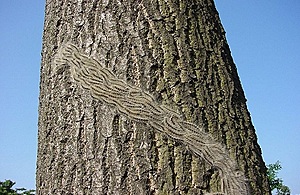Action against oak tree pest underway by Forestry Commission
Tackling oak processionary moth in parts of London and South East England.

Everyone is reminded, particularly those in London and surrounding counties, to report sightings of OPM caterpillars, and to not touch them under any circumstances.
Forestry Commission are acting to tackle the oak tree pest, oak processionary moth in parts of London and South East England.
Oak processionary moth was first identified in London in 2006 and has since spread to some surrounding counties.
The caterpillars and their nests contain hairs which can cause itchy rashes, eye and throat irritations, so a Government programme is in place to limit their spread. They can also occasionally cause breathing difficulties in people and pets, so should not be touched under any circumstances.
People with infested trees in the control zone have been advised that work needs to take place over the next two months to help stop the spread of this pest. Contractors spraying affected trees on behalf of the Forestry Commission will carry out work safely, adhering to social distancing guidelines.
Craig Harrison, the Forestry Commission’s South-East England Director, said:
Green spaces with trees are proving particularly valuable for visitors of woodlands, who are exercising whilst practicing social distancing this spring.
Controlling OPM will help protect oak tree health and ensure continued enjoyment of parks and woodland by reducing the impact of OPM caterpillars to human health.
Everyone is reminded, particularly those in London and surrounding counties, to report sightings of OPM caterpillars, which could be damaging oak trees in their area.
Any sightings should be reported to the Forestry Commission via TreeAlert. Alternatively, people can email opm@forestrycommission.gov.uk or call 0300 067 4442.
The Forestry Commission, councils and land managers have an annual programme in place to tackle the pest, which affects certain part of the country in the spring.
How to identify OPM
Nests are typically dome or teardrop-shaped, averaging the size of a tennis ball. They are white when fresh, but soon become discoloured and brown. The caterpillars have black heads and bodies covered in long white hairs which contain proteins which can cause irritations and occasionally, breathing difficulties.
The greatest risk period is May to July, when the caterpillars’ emerge and feed before pupating into adult moths, but caterpillars and nests should not be touched at any time. The caterpillars feed on oak leaves, which can leave the trees vulnerable to other pests and diseases and drought.
Anyone pruning or felling oak trees in the affected areas should contact Forestry Commission England’s Plant Health Forestry Team beforehand on opm@forestrycommission.gov.uk or 0300 067 4442 for advice about safe removal of the material.
Further information is available from the Forestry Commission and advice about stings and bites is available on the NHS Choices website.
Further information
- Sighting reports should include a precise description of the location. An Ordnance Survey grid reference is ideal, otherwise a postal address and/or a clear description of the tree’s exact position, is helpful, as are clear photographs.
- Forestry Commission’s latest operational update in relation to Covid-19 can be read here
- For further information, contact the Defra Press Office on 020 8225 7318. Out-of-hours, please call 034 5051 8486.